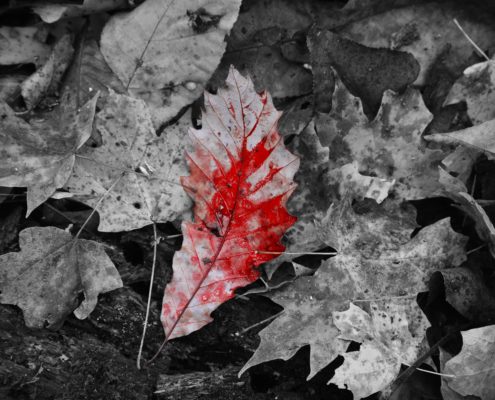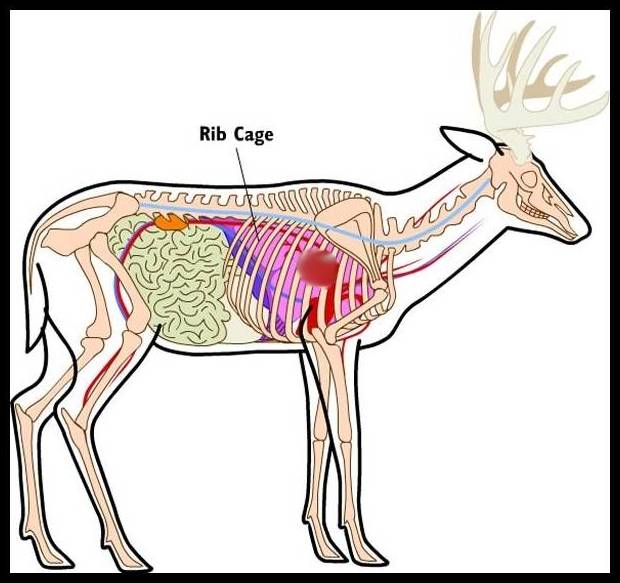30 Sep FIRST BLOOD!!!
The buck stepped closer into the shooting lane. He was just a few steps away as I drew the bow and settled in for the shot. Just as he entered the open lane, I grunted, and the buck stopped. Thwack! It sounded, and felt like, a perfect shot but…

All deer hunters have been at this place. Did I make a perfect shot or…? Whether you are an archer or gun hunter, the issue is the same. The only main difference is usually the range. With a rifle, the shot may have been hundreds of yards. With a bow, it is usually less than 20 yards.
On an archery elk hunt, I had a friend shoot 35 yards at a broadside bull. The arrow sounded right, and the bull rolled, tumbled, kicked, and flopped down the hill. There was no way he missed. When we got the shot site, there was not a single drop of blood. Entire shrubs, bushes and trees were broken in half, but no blood. I marked the spot where the elk stood and began a more thorough search for the arrow. There 10 yards away, sticking in s stump, was a blood free shaft. He had shot low, but the bull saw the arrow coming and danced out of the way.
Unless you have video of the shot, you are guessing about the impact. Once you look at the blood, you can better judge the shot. Lung shots produce frothy blood, heart shots are bright red, etc. Situations are always different, but here are some thoughts about First Blood. Now is the time for patience!
Deer are incredible survivors. They can take amazing damage from arrows, slugs, bullets, or impacts, and survive. The blood of a deer clots incredibly fast. Wounds can seal up in a hurry. I have seen bucks with broadheads and bullets, in or near their hearts that were years old. A calloused membrane had encased the blades or slugs. One huge bull elk shot along the Missouri Breaks, in Montana, had survived 7 arrow wounds. All 7 points were still in his body! Some meat was infected, and had festered, but the bull was alive and kicking.
Every shot should take out the lungs. If the critter can’t breathe, they will pile up. Forget taking head shots, frontal, spine, and ass shots. Take out the lungs. Our best intentions sometimes fail.

HEART/LUNG SHOTS
Killing a deer is about bleeding. If you don’t hit a major artery or blood area, the shot will not quickly be effective. If this shot is on target, you usually watch or hear the deer fall. If you don’t have this outcome, wait at least 30 minutes before you go to the deer. Take some pictures, relax, text, or just chill. Make sure that you locate the last place you saw the deer. Now find your arrow. The arrow will tell you the truth. If there is blood on the shaft, it came from the deer. What kind of blood is it? Bubbly and frothy means lungs.
GUT SHOT
This is the deer hunter’s nightmare. It means a slow kill and tainted meat. The arrow will have stomach contents on it. If you can confirm this shot, back off and wait several hours or come back the next day. Otherwise, you will just keep pushing the deer out of its bed. It may run off the property or into another hunter.
ONE LUNG
If the deer is angled when you shoot, you may only tag one lung. The blood will be pink and bubbly. It looks like a perfect shot, but the deer is hard to find. This deer can still be mobile so scut ahead. Search water holes and streams.
MARGINAL HITS
If you are not sure where you hit, he critter, things can get tough. Not seeing the arrow hit the deer is a problem. Not finding the arrow or much blood at the kill spot does not help. These hits are usually a muscle hit and without cutting an artery, chances are slim to find this deer.
HEART SHOT
If you hit the pump, two things will happen. Blood will be everywhere, and deer will usually go down fast. BUT… I still remember seeing a picture of an elk with a Zwickey broadhead in the center of its heart. The bull lived several years after the wound. Deer are tough critters. Without the right shot, they can survive.
LIVER
If the deer clamps its tail to their body after the shot, there is a good chance you hit too far back and tagged the liver. Blood will be sparse ad dark. Wait 3-6 hours before following up. This shot is fatla, but if you push the wounded deer, it will run and leave little blood.
NON-VITAL HITS
Blood tells the tale. If you see little blood, the outcome can be that you will not find the deer. If you are tracking this deer, look ahead for the deer as well as its trail. Sneak along to avoid jumpin the deer. Look for a bedded deer and be ready to shoot again. Use binoculars to scan ahead. You are trying to see the deer before it sees you. If you lose this deer, it will probably survive.
If you lose a deer, look at the map and consider searching along watershed edges. Wounded deer need to drink. They also tend to go downhill. Tracking dogs can be helpful. If it is past time, look for birds feeding on the carcass. You may still acquire the rack. Don’t forget to call up some hunting buddies for help. More eyes can see more sign.
Every case is different. The best way to ensure a mortal kill is practice and preparation. If your bow and scope are sighted in, accurate shots are more likely. Plan for that one best shot! Be confident in your trigger pull or release. This can only come from hours of practice.
Aim small, miss small!
Montana Grant
For more Montana Grant, aim for him at www.montanagrantfishing.com.


